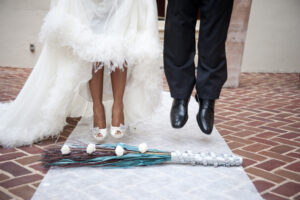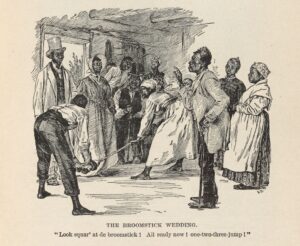One of the unique cultural touches accompanying many Black weddings these days is the tradition known as jumping the broom. Wedding Wire calls it “a reclamation of Black history,” spanning centuries and continents, with “roots in the African diaspora and slavery.”

The practice of jumping the broom at Black weddings first broke into pop culture by Alex Hailey’s “Roots” series in 1977, and again by the 2011 romantic comedy starring Paula Patton, Laz Alonso, and Angela Bassett. The practice really took off with publication of the 1992 book “Broom Jumping: A Celebration of Love” by Danita Rountree Green.
Oddly enough, though, there are questions about the actual origins of the practice.

Conflicting stories
Some say jumping the broom began in Wales in the 18th Century when Roma people were not allowed to marry in the church. Instead, they jumped a broom to signify their union.
Others believe it originated in West Africa, where brooms were used as a way to ward off evil spirits. This, however, is a myth according to several historians. The late folklore professor and author Alan Dundes maintained there are no recorded instances of jumping the broom in Africa prior to the start of the Transatlantic Slave Trade.
Historian Tyler Parry, who has studied West African wedding traditions, agrees.
“I found nothing about jumping the broom there,” Parry told Insider.com. “It just doesn’t exist.”
The real story?
It turns out, the custom likely migrated from Britain’s Pre-Christian Roman and Celtic tradition to the colonies, Dianne M. Stewart, an associate professor of religion and African American studies at Emory University, wrote on OprahDaily.com.
Apparently, white enslavers “imposed the foreign custom upon couples who desired a symbolic ritual,” she says, in lieu of a traditional church wedding.
Other sources say enslaved people who saw poor whites around them performing it to get married embraced the ritual on their own, she writes.
Despite its questionable beginnings, couples who incorporate it into their own nuptials today see it as a “gesture of solidarity” with their ancestors, according to Stewart.
One of the most popular venues for Black and African-American weddings in Miami is the Historic Alfred I. duPont Building. Originally an Art Deco bank vault built by the financier Alfred I. duPont, its marble floors, huge ballrooms, and intricately painted cypress ceilings create an ideal setting for any wedding.
